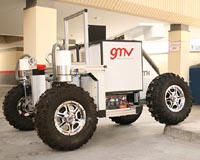 |
Ithaca NY (SPX) May 22, 2009 After thoroughly investigating Victoria Crater on Mars for two years, the instruments aboard the Rover Opportunity reveal more evidence of our neighboring red planet's windy, wet and wild past. The overview of the findings - compiled in one source - is published in the latest issue of the journal Science (May 22, 2009). Opportunity's two-year exploration of Victoria Crater - a half-mile wide and 250 feet deep - yielded a treasury of information about the planet's geologic history and supported previous findings indicating that water once flowed on the planet's surface, according to Steve Squyres, Cornell professor of astronomy and the principal investigator for NASA's Mars Exploration Rover mission. The rover is now heading south toward Endeavor crater, 8.5 miles away. Many of those observations - of hematite spheres ("blueberries"), sulfate-rich sandstone and small chunks of rock containing kamacite, troilite and other minerals commonly found in meteorites - are consistent with Opportunity's findings across Meridiani Planum. "It shows that the processes that we investigated in detail for the first time at Endurance crater [where Opportunity spent six months in 2004] are regional in scale, [indicating that] the kinds of conclusions that we first reached at Endurance apply perhaps across Meridiani," said Squyres. Still, there are a few key differences. The rim of Victoria Crater is about 30m higher than the rim of Endurance, said Squyres; and as the rover drove south toward Victoria the hematite blueberries in the soil became ever fewer and smaller. Rocks deep inside the crater, however, contained big blueberries - indicating that the rocks higher up had less interaction with water - and thus the water's source was likely underground. Detailed analysis of the Victoria data will occupy researchers for years to come, said Jim Bell, professor of astronomy and leader of the mission's Pancam color camera team. Meanwhile, on the other side of the planet in Gusev crater, Opportunity's twin rover Spirit caused consternation with an unexplained computer reboot in April. That problem hasn't recurred, but the rover is now stuck, possibly belly-deep, in a patch of fine Martian soil. "The vehicle seems to be in a unique combination of soft, sandy material and slopes that we haven't encountered yet," said Bell. "Neither one has been particularly problematic in the past, but the combination of the two has us bogged down." In 2005 Opportunity faced a similar quandary when it found itself mired down for a month in a sand trap named Purgatory Dune. "We're not calling this purgatory for Spirit yet, but it has that potential," Bell said. Rover team members - including Cornell senior research associate Rob Sullivan, who played a leading role in freeing Opportunity from Purgatory Dune - are using data from the rover and from NASA's Mars Odyssey orbiter and Mars Reconnaissance Orbiter to plan Spirit's escape. Opportunity, for its part, remains healthy after nearly 1900 sols (Martian days) on the planet - more than 1800 sols beyond its projected lifespan. "We're living on borrowed time," Squyres said of both rovers. "But we're pushing onward as hard as we can." Share This Article With Planet Earth
Related Links Cornell University Mars News and Information at MarsDaily.com Lunar Dreams and more
 GMV To Build First All-Terrain Vehicle For Space For ESA
GMV To Build First All-Terrain Vehicle For Space For ESAMadrid,l Spain (SPX) May 14, 2009 GMV has been commissioned by the European Space Agency (ESA) and Thales Alenia Space Italy (TAS-I) to build a prototype of an all-terrain, rover-type vehicle for Space to explore the surface of Mars and the Moon. This prototype, called EGP-Rover, is part of another larger project called EGP (Eurobot Ground Prototype), which has been awarded to Thales Alenia Space by ESA. EGP is a prototype ... read more |
|
| The content herein, unless otherwise known to be public domain, are Copyright 1995-2009 - SpaceDaily. AFP and UPI Wire Stories are copyright Agence France-Presse and United Press International. ESA Portal Reports are copyright European Space Agency. All NASA sourced material is public domain. Additional copyrights may apply in whole or part to other bona fide parties. Advertising does not imply endorsement,agreement or approval of any opinions, statements or information provided by SpaceDaily on any Web page published or hosted by SpaceDaily. Privacy Statement |